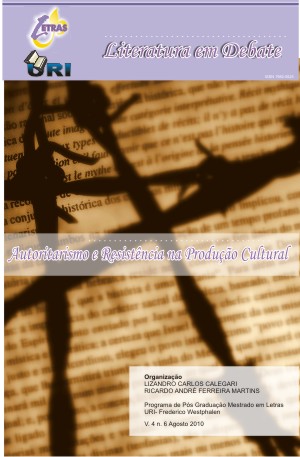DOSTOIÉVSKI E GODARD SOBRE A ESTÉTICA DA REVOLUÇÃO
Palabras clave:
Revolução. Niilismo. Dostoiévski. Godard.Resumen
Tanto Dostoiévski quanto Godard produziram obras que tematizaram, de forma aguda, a ideia de revolução. Os demônios, publicado em 1870 por Dostoiévski, tida como uma obra reacionária, desenvolve os momentos constitutivos das atividades revolucionárias a partir de um núcleo niilista na Rússia da segunda metade do século XIX, enquanto La Chinoise,
filmado por Godard em 1967, geralmente aceito como filme revolucionário, retrata um grupo ativista na França no período imediatamente antecedente ao Maio de 68. O presente propósito é o de investigar a interpretação usualmente atribuída a essas obras e estabelecer as suas devidas conexões, a partir dos temas do niilismo e da revolução.
DOSTOEVSKY AND GODARD CONCERNING THE REVOLUTION ESTHETICS
As much as Dostoiévski, Godard produced wors that approached, in a deep
way, the idea of revolution. Dostoevsky’s work of 1870, The Demons, usually read as a conservative production, develops the constitutive moments of the revolutionary activities from a nihilistic nucleus in the Russia in the second half of the nineteenth century, while La Chinoise,
directed by Godard in 1967, generally accepted as revolutionary film, pictures an activist group in France in the period that immediately precedes the May of 68. The present intention is to investigate the standard interpretation of these works, establishing their connections from the point of view of the nihilism and the revolution.
Publicado
Cómo citar
Número
Sección
Licencia

O trabalho Revista Literatura em Debate de Revista Literatura em Debate foi licenciado com uma Licença Creative Commons - Atribuição 3.0 Não Adaptada.
A submissão de artigos, resenhas e trabalhos de escrita criativa significa que o autor(es) está(ão) cedendo gratuitamente à revista direitos autorais para publicação dos textos e concordando com as normas de submissão apresentadas pelo periódico.
Em caso de republicação, solicita-se apenas referendar o ano e volume de nossa revista onde ocorreu a publicação inicial.

